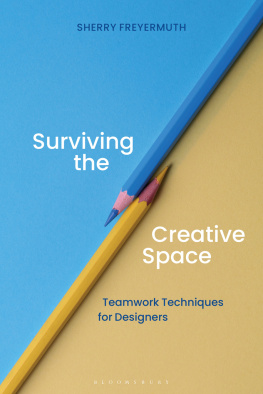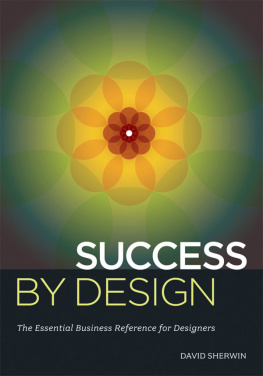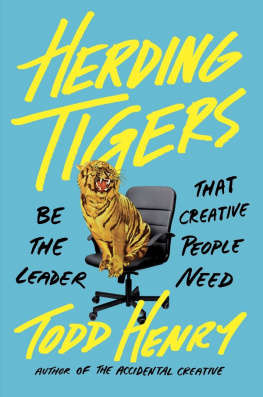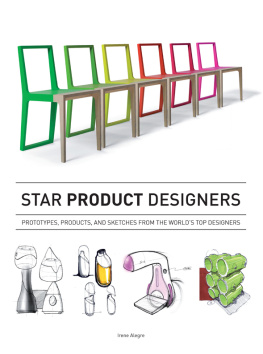
BLOOMSBURY VISUAL ARTS
Bloomsbury Publishing Plc
50 Bedford Square, London, WC1B 3DP, UK
1385 Broadway, New York, NY 10018, USA
29 Earlsfort Terrace, Dublin 2, Ireland
This electronic edition published in 2022 by Bloomsbury Publishing Plc
BLOOMSBURY, BLOOMSBURY VISUAL ARTS and the Diana logo are trademarks of Bloomsbury Publishing Plc
First published in Great Britain 2022
Copyright Bloomsbury, 2022
Sherry Freyermuth has asserted her right under the Copyright, Designs and Patents Act, 1988, to be identified as Author of this work.
For legal purposes the constitute an extension of this copyright page.
Cover image courtesy of Pexels
Cover design by Sherry Freyermuth
All rights reserved
You may not copy, distribute, transmit, reproduce or otherwise make available this publication (or any part of it) in any form, or by any means (including without limitation electronic, digital, optical, mechanical, photocopying, printing, recording or otherwise), without the prior written permission of the publisher. Any person who does any unauthorised act in relation to this publication may be liable to criminal prosecution and civil claims for damages.
Bloomsbury Publishing Plc does not have any control over, or responsibility for, any third-party websites referred to or in this book. All internet addresses given in this book were correct at the time of going to press. The author and publisher regret any inconvenience caused if addresses have changed or sites have ceased to exist, but can accept no responsibility for any such changes.
A catalogue record for this book is available from the British Library.
A catalog record for this book is available from the Library of Congress.
ISBN: 978-1-3500-4050-2 (PB)
ISBN: 978-1-3500-4052-6 (eBook)
ISBN: 978-1-3500-4051-9 (ePDF)
To find out more about our authors and their books please visit www.bloomsbury.com where you will find extracts, author interviews and details of forthcoming events, and to be the first to hear about latest releases and special offers, sign up for our newsletters.
This book is dedicated to all the art and design students Ive taught throughout my career. Your questions, curiosity, and insights inspired me to write this book.
CONTENTS
As a graphic design professor, I often talk with my students about professional practices and life after graduation. I like to ask about their career goals and where they see themselves working in the future. Students frequently find the agency world of design sexier and more appealing creatively than working in-house, or, despite a limited understanding of developing a freelance practice, they romanticize what it would mean to be their own boss. Because I only have experience on in-house creative teams, I find these assumptions both intriguing and alarming. I loved both my experiences working for in-house creative teams, one as part of a three-person team in a non-profit agency designing for the city of Boston, Massachusetts, and the other as part of a large, 80+-person in-house advertising agency for Discovery Communication (now Discovery Inc.), the media power house that owns Discovery Channel, TLC, Science Channel, and Animal Planet. These were drastically different environments with very different responsibilities, and I grew significantly in each role. If I hadnt been open to working in-house, I would have missed out on two excellent job opportunities that have come to shape much of my creative work and collaborative skills today.
Widespread assumptions and misconceptions about different creative team environments prompted me to write this book, Surviving the Creative Space. In it, I introduce readers to the various types of creative teams and dissect what the successful ones are doing well, so that emerging professionals can use this book as a guide to help navigate the tricky space where creative output is monetized. How is creative work completed effectively without losing inspiration, spirit, and the love of design? How does collaboration and creativity happen under the pressures of efficiency? How does communication work best among creative teams? What can you do to become an invaluable member of your creative team? Through case studies and interviews, it is my hope to offer answers to these questions, and allow readers an insiders look at successful creative teams in the agency, in-house, and freelance worlds of design. Though many of the featured professionals have since changed positions or shifted the direction of their creative careers, teamwork remains essential to their practice, as it will be for you as you enter the professional design world.
Many aspiring designers begin their career by building strong portfolios and focusing on their own individual development as a creative professional. Getting a job in design, advertising, or any other creative field does require strong craftsmanship and a command of industry-leading tools, and the importance of a strong portfolio cannot be understated. But this common approach overlooks a crucial aspect of design-world success. It overlooks the importance of understanding collaboration and teamwork. How is teamwork structured in different types of creative teams? What skills are required to be a great teammate? How can a reliable mentor transform creative development and open up new professional opportunities?
Surviving the Creative Space: Teamwork Techniques for Designers is a guide for emerging creative professionals in the early stages of their career. This book offers readers practical examples of teamwork structures in creative fields such as advertising, graphic design, motion design, and marketing. It provides a deep look into the structures of agency teams, in-house creative teams, and freelance teams, and offers tips for cultivating a rich creative community to enrich your creative life and foster professional connections.
Collaboration underlies the best creative work, and this book provides advice and exercises to help readers understand their own teamwork habits and develop skills to become strong collaborators. By learning how creative teams work and how to work effectively within them, you will become better at sharing ideas, incorporating feedback, and developing skills to persuasively present work.
Collaboration isnt only a key tool for improving creative work. Its also key for getting creative work. Oftentimes creative professionals at the junior level dont get the most creative projects until theyve proven their ability to complete more basic tasks, make deadlines, and understand the work culture and dynamics of the creative team. The better a person is at adapting to their role on the team, the more responsibilities theyll be given and the faster theyll be able to advance within the team structure.
Designer Michael Bierut describes what makes creative teams unique: I think that creative people have an interesting tension between the individual (each persons unique artistic vision) and the collective (the goals that can only be achieved through collaboration). Being able to navigate between ones individual creative voice and the collective goals of a team in order to bring an idea to life is a key component of success on a creative team.
Creative teams are important because their work impacts behavior, culture, attitudes, and opinions. The subjective nature of creative work makes it challenging to nail down the value a creative team can bring to an organization. When thinking of creative work, some people may envision a lone artist toiling away in their studio, but the reality is very different. As designer and educator Aggie Toppins has observed, focusing on individual creation is not an accurate way to understand design artifacts and learn about design processes. Today, as in the past, creative work always involves creative teams.














